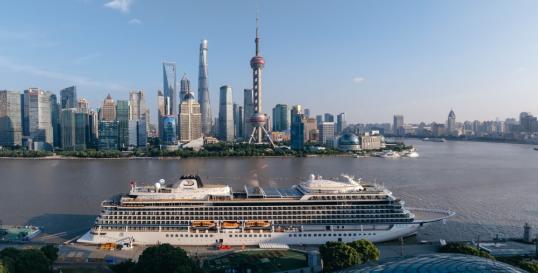Cruises, visa-free entries boost tours to China
Foreign tourists visiting nation forecast to exceed 15 million in H2

Viking Yidun, the first Chinese-flagged luxury cruise ship, docks in Shanghai in September.(Photo/China Daily)
Hundreds of foreign visitors flew to Shanghai this fall to board the first cruise ship designed specifically for international travelers visiting China.
Operated by international cruise company Viking Cruises, the tours include four routes and last between 10 and 20 days, stopping at major Chinese cities such as Beijing, Shanghai and Hong Kong, as well as smaller cities such as Pingtan, Fujian province, and Dongtou, Wenzhou, Zhejiang province.
Targeting international visitors who are generally conversant in English, the voyages are being operated by 930-guest Viking Yidun, the first Chinese-flagged luxury ocean cruise ship. Eight such voyages will be operated in total between September and November.
For the 20-day tour, the trip will start and end in Beijing, and stop at inland cities such as Chengdu, Sichuan province; Lhasa, Xizang autonomous region; and Xi'an, Shaanxi province. The inland itineraries will be operated by flights, Viking said.
"We are prepared to make significant investments in China, just like we did in the United States market, where we spent $3 billion over time to build our brand. We see a huge opportunity in China and are committed to making substantial, long-term investments," said Torstein Hagen, founder, chairman and CEO of Viking Cruises. "I have huge confidence in the Chinese market. We will keep pushing forward and developing the market, but it will take time. We see this as the time to commit and position ourselves for the future."
China has adopted unprecedented policies to facilitate foreign visitors' entry and transit into the country since the latter half of 2023. By continuously adding new countries to the list that their citizens can enter China with unilateral visa-free policies, the nation's inbound tourism has witnessed significant momentum in growth.
In May, a 15-day visa-free entry policy came into effect for foreign tour groups arriving at 13 Chinese ports via cruise ships and received by Chinese travel agencies.
Globally, the cruise tourism market is showing strong signs of recovery. Viking said it remains optimistic about the growth prospects of China for the next two years, fueled by the enormous growth potential of the market, and is actively preparing next year's routes that will be optimized on market demand and passenger feedback from this year's tours.
Bringing US travelers on board the Chinese-flagged luxury cruise ship, the inaugural sailing in September was booked with more than 650 guests, a number the company said was beyond its expectations.
Hagen said people's understanding of different countries is sometimes influenced by one-sided information. Yet, facts are often more diverse and colorful than stereotypes.
He added that China is a safe, clean and vibrant country, and Chinese people are hardworking, intelligent, friendly and enthusiastic. The company hopes to provide international tourists with a comfortable and safe travel experience, and enable more people to understand the real China through word-of-mouth.
By 2035, China's cruise tourism market is expected to see a scale of 14 million passenger trips a year, and sales of the market are foreseen to reach 531.7 billion yuan ($74.73 billion), according to a forecast by the Shanghai Academy of Social Sciences.
China's inbound tourism sector has witnessed remarkable growth momentum. So far this year, for every four inbound foreign visitors, one of them has been to China before. Daily average booking volumes of travel products by visitors who come from Italy, Malaysia, Russia and the US have more than tripled on a yearly basis, according to Trip.com Group.
During the National Day holiday in the first week of October, booking volumes of inbound travel products hit a record high compared with the same period historically. During the break, more than 50 percent of foreign visitors stayed for more than seven days in China, Trip.com said.
Some of the most popular inbound tourism destinations include major domestic cities such as Shanghai; Shenzhen and Guangzhou in Guangdong province; Beijing; Chengdu; and Hangzhou, Zhejiang.
"Besides, some niche domestic destinations for foreigners became newly added hot destinations for them during the break. Those places include Guiyang, Guizhou province; Lanzhou, Gansu province; Guilin; Guangxi Zhuang autonomous region; Qinhuangdao, Hebei province; and Yantai, Shandong province," said Mao Lin, a researcher with Trip.com.

Visitors browse a market in Shanghai in September. [Photo/China Daily]
For the latest development, China has expanded the scope of unilateral visa-free entries for ordinary passport holders from Portugal, Greece, Cyprus and Slovenia, according to the Ministry of Foreign Affairs.
From Oct 15 to Dec 31, 2025, individuals holding ordinary passports from the above-mentioned countries who come to China for business, tourism, visiting relatives and friends, and transit for no more than 15 days are eligible for visa-free entry, the ministry said.
In the first half of this year, 14.64 million foreigners entered China from different ports across the country, jumping 152.7 percent year-on-year. Among them, 8.54 million foreigners entered the country using visa-free entries, surging 190.1 percent year-on-year, according to the National Immigration Administration.
In the latter half of this year, the number of foreigners visiting China is expected to exceed 15 million, according to a forecast by the China Tourism Academy.
"For the second half of this year, China's inbound tourism market is expected to recover to the same level seen in 2019, or before the COVID-19 pandemic period, and enter a new cycle of prosperity and growth," said Dai Bin, president of the China Tourism Academy.
Meanwhile, local governments have been making more efforts to promote the high-quality growth of inbound tourism. For instance, Shanghai is building itself as the first destination for inbound tourism, according to a research report by the China Tourism Academy.
"Beijing, Hainan province, Anhui province and other provinces and cities have held multiple inbound tourism conferences and events, and built closer connections with international travel industry players," said Liu Xiangyan, a researcher with the academy. "In East China's Anhui, where the renowned Huangshan Mountain is located, the local government has been comprehensively promoting the building of itself as a world-class tourist destination and developing inbound tourism."

